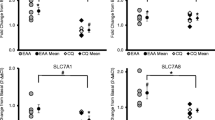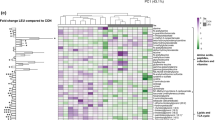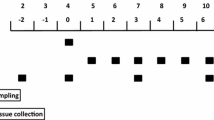Abstract
Previously we demonstrated that the insulin- and amino acid-induced activation of the mammalian target of rapamycin complex 1 (mTORC1) is developmentally regulated in neonatal pigs. Recent studies have indicated that members of the System A transporter (SNAT2), the System N transporter (SNAT3), the System L transporters (LAT1 and LAT2), and the proton-assisted amino acid transporters (PAT1 and PAT2) have crucial roles in the activation of mTORC1 and that the abundance of amino acid transporters is positively correlated with their activation. This study aimed to determine the effect of the post-prandial rise in insulin and amino acids on the abundance or activation of SNAT2, SNAT3, LAT1, LAT2, PAT1, and PAT2 and whether the response is modified by development. Overnight fasted 6- and 26-day-old pigs were infused for 2 h with saline (Control) or with insulin or amino acids to achieve fed levels while amino acids or insulin, respectively, as well as glucose were maintained at fasting levels. The abundance of SNAT2, SNAT3, LAT1, LAT2, PAT1, and PAT2 was higher in muscle of 6- compared with 26-day-old pigs. The abundance of the PAT2–mTOR complex was greater in 6- than in 26-day-old pigs, consistent with the higher activation of mTORC1. Neither insulin nor amino acids altered amino acid transporter or PAT2–mTOR complex abundance. In conclusion, the amino acid transporters, SNAT 2/3, LAT 1/2, and PAT1/2, likely have important roles in the enhanced amino acid-induced activation of mTORC1 in skeletal muscle of the neonate.




Similar content being viewed by others
References
Davis TA, Fiorotto ML, Nguyen HV et al (1989) Protein turnover in skeletal muscle of suckling rats. Am J Physiol 257:R1141–R1146
Davis TA, Burrin DG, Fiorotto ML et al (1996) Protein synthesis in skeletal muscle and jejunum is more responsive to feeding in 7- than in 26-day-old pigs. Am J Physiol 270:E802–E8096
Drummond MJ, Glynn EL, Fry CS et al (2010) An increase in essential amino acid availability upregulates amino acid transporter expression in human skeletal muscle. Am J Physiol Endocrinol Metab 298:E1011–1018
Drummond MJ, Dickinson JM, Fry CS et al (2012) Bed rest impairs skeletal muscle amino acid transporter expression, mTORC1 signaling, and protein synthesis in response to essential amino acids in older adults. Am J Physiol Endocrinol Metab 302:E1113–E1122
Escobar J, Frank JW, Suryawan A et al (2005) Physiological rise in plasma leucine stimulates muscle protein synthesis in neonatal pigs by enhancing translation initiation factor activation. Am J Physiol Endocrinol Metab 288:E914–E921
Evans K, Nasim Z, Brown J et al (2007) Acidosis-sensing glutamine pump SNAT2 determines amino acid levels and mammalian target of rapamycin signalling to protein synthesis in L6 muscle cells. J Am Soc Nephrol 5:1426–1436
Fuchs BC, Bode BP (2005) Amino acid transporters ASCT2 and LAT1 in cancer: partners in crime? Semin Cancer Biol 15:254–266
Goberdhan DC (2010) Intracellular amino acid sensing and mTORC1-regulated growth: new ways to block an old target? Curr Opin Invest Drugs 11:1360–1367
Goberdhan DC, Meredith D, Boyd CA et al (2005) PAT-related amino acid transporters regulate growth via a novel mechanism that does not require bulk transport of amino acids. Development 132:2365–23754
Gran P, Cameron-Smith D (2011) The actions of exogenous leucine on mTOR signalling and amino acid transporters in human myotubes. BMC Physiol 11:1–10
Hamdi MM, Mutungi G (2011) Dihydrotestosterone stimulates amino acid uptake and the expression of LAT2 in mouse skeletal muscle fibres through an ERK1/2-dependent mechanism. J Physiol 589:3623–3640
Heublein S, Kazi S, Ogmundsdóttir MH et al (2010) Proton-assisted amino-acid transporters are conserved regulators of proliferation and amino-acid-dependent mTORC1 activation. Oncogene 29:4068–4079
Kaira K, Oriuchi N, Takahashi T et al (2011) LAT1 expression is closely associated with hypoxic markers and mTOR in resected non-small cell lung cancer. Am J Transl Res 3:468–478
Kurayama R, Ito N, Nishibori Y et al (2011) Role of amino acid transporter LAT2 in the activation of mTORC1 pathway and the pathogenesis of crescentic glomerulonephritis. Lab Invest 91:992–1006
Liu XM, Reyna SV, Ensenat D et al (2004) Platelet-derived growth factor stimulates LAT1 gene expression in vascular smooth muscle: role in cell growth. FASEB J 18:768–770
Mackenzie B, Erickson JD (2004) Sodium-coupled neutral amino acid (System N/A) transporters of the SLC38 gene family. Pflugers Arch 447:784–795
McGivan JD, Bungard CI (2007) The transport of glutamine into mammalian cells. Front Biosci 12:874–882
Nawashiro H, Otani N, Shinomiya N et al (2006) l-type amino acid transporter 1 as a potential molecular target in human astrocytic tumors. Int J Cancer 119:484–492
Nicklin P, Bergman P, Zhang B et al (2009) Bidirectional transport of amino acids regulates mTOR and autophagy. Cell 136:521–534
O’Connor PM, Bush JA, Suryawan A et al (2003) Insulin and amino acids independently stimulate skeletal muscle protein synthesis in neonatal pigs. Am J Physiol Endocrinol Metab 284:E110–E119
Onan MC, Fisher JS, Ju JS et al (2005) Type I diabetes affects skeletal muscle glutamine uptake in a fiber-specific manner. Exp Biol Med 230:606–611
Palacín M, Estévez R, Bertran J et al (1998) Molecular biology of mammalian plasma membrane amino acid transporters. Physiol Rev 78:969–1054
Pinilla J, Aledo JC, Cwiklinski E et al (2011) SNAT2 transceptor signalling via mTOR: a role in cell growth and proliferation? Front Biosci 3:1289–1299
Reynolds B, Laynes R, Ogmundsdóttir MH et al (2007) Amino acid transporters and nutrient-sensing mechanisms: new targets for treating insulin-linked disorders? Biochem Soc Trans 35:1215–1217
Riazi R, Wykes LJ, Ball RO et al (2003) The total branched-chain amino acid requirement in young healthy adult men determined by indicator amino acid oxidation by use of l-[1-13C] phenylalanine. J Nutr 133:1383–1389
Sidoryk M, Matyja E, Dybel A et al (2004) Increased expression of a glutamine transporter SNAT3 is a marker of malignant gliomas. NeuroReport 15:575–578
Suryawan A, Davis TA (2010) The abundance and activation of mTORC1 regulators in skeletal muscle of neonatal pigs are modulated by insulin, amino acids, and age. J Appl Physiol 109:1448–1854
Suryawan A, Escobar J, Frank JW et al (2006) Developmental regulation of the activation of signaling components leading to translation initiation in skeletal muscle of neonatal pigs. Am J Physiol Endocrinol Metab 291:E849–E859
Suryawan A, Orellana RA, Nguyen HV et al (2007) Activation by insulin and amino acids of signaling components leading to translation initiation in skeletal muscle of neonatal pigs is developmentally regulated. Am J Physiol Endocrinol Metab 293:E1597–E1605
Suryawan A, O’ Connor PM, Bush JA et al (2009) Differential regulation of protein synthesis by amino acid and insulin in peripheral and visceral tissues of neonatal pigs. Amino Acids 37:97–104
Taylor PM (2009) Amino acid transporters: éminences grises of nutrient signalling mechanisms? Biochem Soc Trans 37:237–241
Tennant DA, Durán RV, Boulahbel H et al (2009) Metabolic transformation in cancer. Carcinogenesis 30:1269–1280
Wang X, Proud CG (2011) mTORC1 signaling: what we still don’t know. J Mol Cell Biol 3:206–220
Wilson FA, Suryawan A, Orellana RA et al (2011) Differential effect of long-term leucine infusion on tissue protein synthesis in neonatal pigs. Amino Acids 40:157–165
Wu G (2012) Functional amino acids in growth, reproduction, and health. Adv. Nutr. 1:31–37
Zoncu R, Efeyan A, Sabatini DM (2011) mTOR: from growth signal integration to cancer, diabetes and ageing. Nat Rev Mol Cell Biol 12:21–35
Acknowledgments
These studies were supported by NIH R01 AR44474 and USDA/ARS 6250-510000-055. This work is a publication of USDA/ARS Children’s Nutrition Research Center, Department of Pediatrics, Baylor College of Medicine, Houston, TX. The contents of this publication do not necessarily reflect the views or politics of the USDA, nor does the mention of trade names, commercial products or organizations imply endorsement by the U.S. Government. We thank Jerome Stubblefield and Rickey Bryant for care of animals, and Layla Gullick for secretarial assistance.
Author information
Authors and Affiliations
Corresponding author
Rights and permissions
About this article
Cite this article
Suryawan, A., Nguyen, H.V., Almonaci, R.D. et al. Abundance of amino acid transporters involved in mTORC1 activation in skeletal muscle of neonatal pigs is developmentally regulated. Amino Acids 45, 523–530 (2013). https://doi.org/10.1007/s00726-012-1326-7
Received:
Accepted:
Published:
Issue Date:
DOI: https://doi.org/10.1007/s00726-012-1326-7




